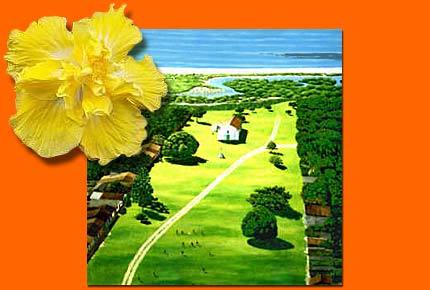| |
| |
Since
having read a few of Jorge Amado's captivating novels about life in Bahia
it had been my dream to go and live in that wondrous land of sensuality,
imagination and joie de vie. Reality, though, is something else
again. |
|
| |
|
|
| |
In
1984, we moved from Nepal to Brazil, to a village by the name of Trancoso,
situated in the prefeitura
of Porto Seguro, the historical environment where Brazil was discovered
in 1500 by Pedro Álvares
Cabral's squadron, who
saw from a distance a rounded elevation - Monte Pascoal. |
|
| |
|
|
| |
If you are interested in the region and its history, the people,
festas and customs, flora and fauna or just like to know how it is to live
and bring up kids in a village in Bahia, you've come to the right place. |
|
| |
|
|
| |
Trancoso
is located on a green (in winter, that is, during summer it's rather yellowish)
plateau overlooking one of the most beautiful beaches of Brazil. The heart
of the place, the quadrado, as the village square is called, is
surrounded by the traditional small houses, a protected historical site.
Right there, near the lower right corner on the aerial view below, we bought
a narrow piece of land and started constructing our house. |
|
| |
|
|
| |
For the
kids, Trancoso was a perfect paradise. For myself, a great opportunity to
be creative, to plan and design: The restaurant bordering the village square,
with our living quarters upstairs, and the Pousada, consisting
of a one-room bungalow and a large building with four guest rooms. |
|
| |
|
|
| |
Meanwhile about 25 years have passed, and Trancoso has become a boomtown of sorts, and a haven for high-society Brazilians from São Paulo, especially. As a result, it now has several upscale developments, such as the Club Med and a US$90-million 18-hole golf course. Trancoso now is one of the most chic beach resorts of Brazil, a playground for the wealthy and famous. For hotels to charge 2000 $ a night for a room is not uncommon. About every fisherman's hut has been turned into a fashionable restaurant or boutique hotel decorated by world famous designers. |
|
| |
But at least the natives made good money selling their properties to rich investors, and often were able to build for each of their children a solid house of much superior quality than their old shacks made of sticks and mud, to open businesses and restaurants, and travel abroad. |
|
| |
|
|
| |
Do I regret having left Trancoso 25 years ago, before it became the "holiday hot spot for those with an eye for beauty and fairly deep pockets – the sort of place where millionaires go to pretend to be poor." Never, not for one second. It never was a place I particularily liked, just not my thing at all. |
|
| |
|
|
| |
 |
|
 |
|
| |
|
|
| |
My greatest pleasure in Brazil was to experience its untamed,
fascinating nature, and to see plants growing out of any dropped seed practically
in front of my eyes. I often fled to the solitude of the woods, not only
to find orchids to transfer to my garden, but also to get away
from the daily chores and to recharge my batteries. |
|
| |
|
|
| |
What I severely missed in Brazil was the wisdom and depths of the ancient cultures
of Asia, Arabia and Northern Africa, places that had been my home for so many years.
I longed for the stupefying architecture, the gorgeous fabrics, the spirituality
of even simple farmers, the elaborately spiced dishes; short all the smells
and sights and sounds, the whole splendor of civilizations consisting of
so many rich layers that the thin icing of modern habits and western ways
is never really able to tarnish the substance. |
|
| |
|
|
| |
Brazil is just about the opposite of those eastern cultures,
a young, a youthful country. Playful, carefree, superficial, innocent, violent, easily
aroused and as easily bored, unembarrassed like some happy toddler. Brazilians
generally are a friendly and open lot, helpful to the point of feeling sufficiently
at home in your house on their first visit to start washing your dishes,
or to hack open a coconut with your treasured racor sharp Chinese kitchen knife. |
|
| |
|
|
| |
|
|
|
|
| |
|
back
to site index |
|
|



